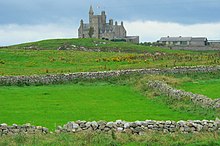Classiebawn Castle
Classiebawn Castle ( Irish Caisleán na Clasaí Baine ) is a country house near the village of Cliffoney on the Mullaghmore Peninsula in Ireland's County Sligo . The house was Henry John Temple, 3rd Viscount Palmerston , built on a former 40 km² large estate (1784-1865). The present country house was mostly built at the end of the 19th century.
description
Classiebawn Castle was designed by J. Rawson Carrol , an architect from Dublin , in the Scottish Baronial style and is built from yellowish-brown sandstone that was brought in by sea from County Donegal . It consists of a gable building with a central tower on which a Tourelle with a conical roof sits.
history
The land that once belonged to the O'Connor Sligo family was confiscated by the English Parliament to compensate the people who put down the Irish Rebellion in 1641 . The approximately 40 km² of land on which Classiebawn Castle stands today was given to Sir John Temple (1600–1677), Master of the Rolls of Ireland .
The property later fell to Henry John Temple, 3rd Viscount Palmerton, a politician who held both the post of British Prime Minister and that of British Foreign Secretary . This Lord Palmerston commissioned the construction of today's Classiebawn Castle, as well as that of the port of Mullaghmore. The house was not finished when he died in 1865, but his stepson and successor, The Rt. Hon. William Cowper-Temple , PC , MP (later promoted to 1st Baron Mount-Temple ) had it finished in 1874. The latter died childless in 1888 and the property fell to his nephew, The Hon. Evelyn Ashley , the second surviving son of Anthony Ashley-Cooper, 7th Earl of Shaftesbury . Evelyn Ashley spent some time there every year and after his death in 1907 he was followed by his only son, Wilfrid Ashley (later promoted to 1st Baron Mount Temple in a new appointment). He also spent his summers in the country house with his two daughters, Edwina , who later became Countess Mountbatten and Mary (1906-1986), who was the second of three wives of Thomas Cholmondeley 1944-1955 Baroness Delamere .
The years under Mountbatten
The house was cleared in 1916 and remained empty until 1950. In July 1939, Edwina, Countess Mountbatten of Burma, and her husband, Fleet Admiral Louis Mountbatten, 1st Earl Mountbatten of Burma , inherited the property and had some improvements made, such as the installation of electrical lighting and a drinking water supply. After the death of his wife in February 1960, Lord Mountbatten, the last Governor General and Viceroy of India, spent his summers in the country house until he was assassinated by the IRA in August 1979 , in which his boat was blown up off the coast of Mullaghmore .
The mansion and surrounding lands now belong to the estate of Hugh Tunney (1928-2011), a late businessman from Trillick , County Tyrone , who bought the 120 acre house in 1991 after leasing it for many years.
Individual evidence
- ^ Profile of an Irish Village - Palmerston and the Conquest, Colonization and Evolution of Mullaghmore, Co. Sligo . Sligo Heritage. Retrieved April 12, 2019.
- ↑ a b c d Classiebawn and it's owners . Retrieved April 12, 2019.
- ^ Alan Cowell: Patricia Knatchbull, a Grande Dame of Britain's Elite, Dies at 93 . In: The New York Times . June 14, 2017. Retrieved April 12, 2019.
- ↑ Albin Krebs: Earl Mountbatten of Burma, 79, Military Strategist and Statesman . In: The New York Times . August 28, 1979. Retrieved April 12, 2019.
Web links
- A short history of Classiebawn Castle . In: The Sacred Island . Retrieved April 12, 2019.
- Liam Collins: An aristocrat, a beef baron and the castle they both came to love . In: The Independent.ie . May 19, 2016. Retrieved April 12, 2019.
Coordinates: 54 ° 27 '18.6 " N , 8 ° 28' 9.6" W.
